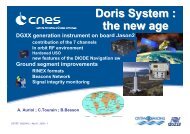IDS activity report 2011 - International DORIS Service
IDS activity report 2011 - International DORIS Service
IDS activity report 2011 - International DORIS Service
Create successful ePaper yourself
Turn your PDF publications into a flip-book with our unique Google optimized e-Paper software.
In the mid-nineties, CNES developed a second-generation dual channel <strong>DORIS</strong> receiver thatwas subsequently miniaturized:• Jason-1, the CNES/NASA TOPEX follow-on mission was launched on December7, 2001 with a miniaturized second generation <strong>DORIS</strong> receiver. The receiver wasswitched on December 8. The orbit accuracy of Jason-1 has been demonstrated tobe close to one cm in the radial component (Luthcke et al. 2003; Haines et al.2004). At the present time, Jason-1 <strong>DORIS</strong> measurements are not used forgeodesy, owing to the South Atlantic Anomaly (SAA) effect on the on-board UltraStable Oscillator (USO) (Willis et al. 2004), however a correction model has beendeveloped (Lemoine and Capdeville 2006),• Envisat, the ESA mission to ensure the continuity of the data measurements of theESA ERS satellites was launched on March 1, 2002 with a second generation<strong>DORIS</strong> receiver• SPOT-5 (CNES) was launched on May 4, 2002 with a miniaturized secondgeneration <strong>DORIS</strong> receiver.Then, a new generation <strong>DORIS</strong> receiver was developed starting in 2005. This receiver calledDGXX, includes the following main new features:1. The simultaneous tracking capability was increased to seven beacons (from only two inthe previous generation of receivers)2. The new generation USO design provides better frequency stability while crossingSAA, and a better quality of MOE useful for beacon location determination.3. New DIODE navigation software (improved accuracy)The following satellites have on board a DGXX receiver:• OSTM/Jason-2 (CNES/NASA/EUMETSAT/NOAA), a TOPEX/Poseidon and Jason-1follow-on ocean observation mission (same orbit), was launched on June 20, 2008.Jason-2 is based on the same PROTEUS platform as Jason-1, but carries the DGXX<strong>DORIS</strong>.• Cryosat-2, the ESA mission dedicated to polar observation, was launched on April 10,2010 with a DGXX <strong>DORIS</strong> receiver.• HY-2A, a Chinese satellite (China Academy of Space) was launched on August 15,<strong>2011</strong> with a DGXX receiver.Moreover, the satellite STPSAT1 (Plasma Physics and Space Systems DevelopmentDivisions, Naval Research Laboratory) with a CITRIS receiver to be used with the <strong>DORIS</strong>beacon network, was launched on March 9, 2007. This experiment was dedicated to globalionospheric measurements.27






